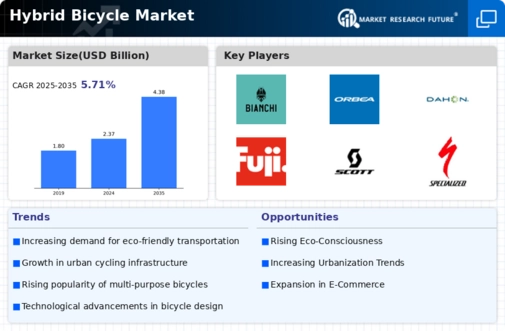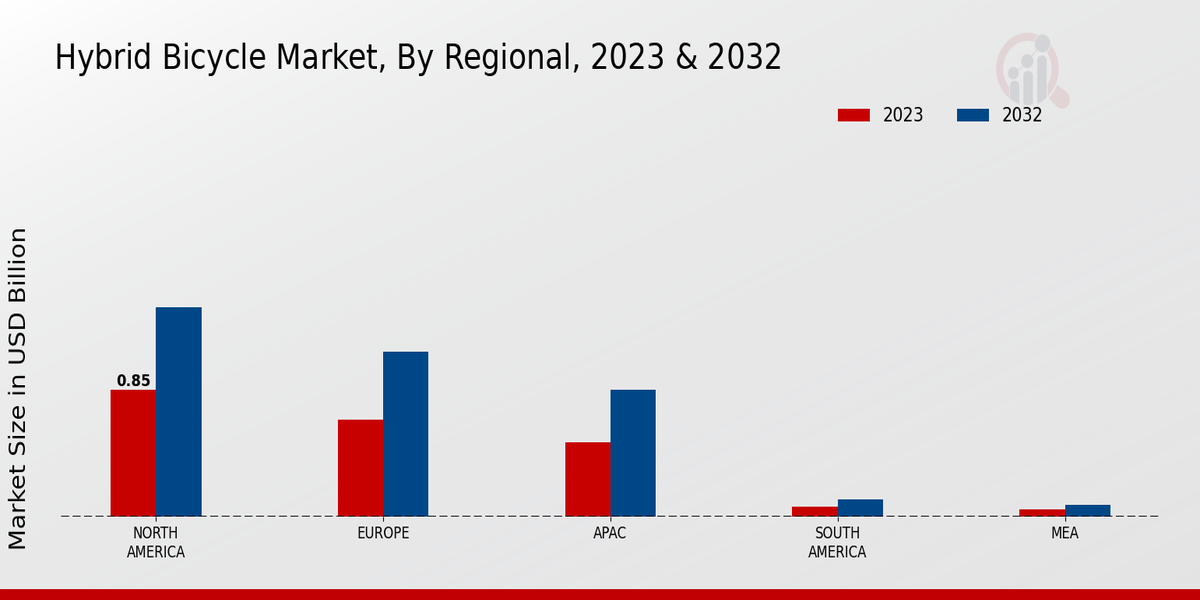Health and Fitness Trends
The rising awareness of health and fitness among consumers plays a pivotal role in the Global Hybrid Bicycle Market Industry. As individuals increasingly prioritize physical activity, hybrid bicycles offer an appealing option for exercise and leisure. They provide a versatile means of transportation that encourages outdoor activity, thereby promoting a healthier lifestyle. This trend is particularly evident in urban areas where cycling is becoming a popular recreational activity. The market's growth is supported by the increasing number of cycling events and community initiatives aimed at promoting cycling as a healthy alternative to sedentary transportation. This shift in consumer behavior is expected to further drive demand for hybrid bicycles.
Market Growth Projections
The Global Hybrid Bicycle Market Industry is poised for substantial growth, with projections indicating a market value of 2.37 USD Billion in 2024 and an anticipated increase to 4.38 USD Billion by 2035. This growth trajectory suggests a robust demand for hybrid bicycles, driven by various factors such as urbanization, technological advancements, and changing consumer preferences. The market is expected to experience a compound annual growth rate (CAGR) of 5.73% from 2025 to 2035, reflecting the increasing adoption of hybrid bicycles as a viable transportation option. These projections underscore the potential for innovation and investment within the hybrid bicycle sector.
Growing Environmental Awareness
The increasing global emphasis on sustainability and eco-friendliness drives the Global Hybrid Bicycle Market Industry. Consumers are becoming more conscious of their carbon footprints and are seeking greener transportation alternatives. Hybrid bicycles, which combine the benefits of traditional bicycles and electric bikes, offer a practical solution for urban commuting while minimizing environmental impact. This trend is reflected in the projected market value of 2.37 USD Billion in 2024, indicating a shift towards sustainable mobility solutions. As cities implement policies to promote cycling and reduce vehicular emissions, the demand for hybrid bicycles is likely to grow, further enhancing their market presence.
Government Initiatives and Incentives
Government policies and incentives aimed at promoting cycling significantly influence the Global Hybrid Bicycle Market Industry. Many governments worldwide are implementing programs to encourage the use of bicycles as a sustainable mode of transport. These initiatives include subsidies for purchasing bicycles, tax incentives for manufacturers, and investments in cycling infrastructure. Such measures not only enhance the attractiveness of hybrid bicycles but also contribute to the overall growth of the market. As urban areas strive to reduce traffic congestion and improve air quality, the support from governmental bodies is likely to foster an environment conducive to the expansion of hybrid bicycle adoption.
Urbanization and Infrastructure Development
Rapid urbanization across the globe contributes significantly to the expansion of the Global Hybrid Bicycle Market Industry. As more people migrate to urban areas, the need for efficient and flexible transportation options becomes paramount. Cities are increasingly investing in cycling infrastructure, such as dedicated bike lanes and parking facilities, which facilitates the use of hybrid bicycles. This trend is expected to bolster the market, with a projected growth rate of 5.73% CAGR from 2025 to 2035. The integration of hybrid bicycles into urban transport systems not only alleviates traffic congestion but also promotes healthier lifestyles among city dwellers.
Technological Advancements in Bicycle Design
Innovations in bicycle technology are reshaping the Global Hybrid Bicycle Market Industry. Manufacturers are incorporating advanced materials and smart technologies into hybrid bicycles, enhancing their performance and appeal. Features such as lightweight frames, improved battery efficiency, and integrated GPS systems are becoming standard. This technological evolution attracts a broader consumer base, including tech-savvy individuals and commuters seeking convenience. As a result, the market is anticipated to reach 4.38 USD Billion by 2035, reflecting the growing consumer preference for high-performance bicycles that cater to modern lifestyles. The continuous evolution of hybrid bicycle design is likely to sustain market growth.








